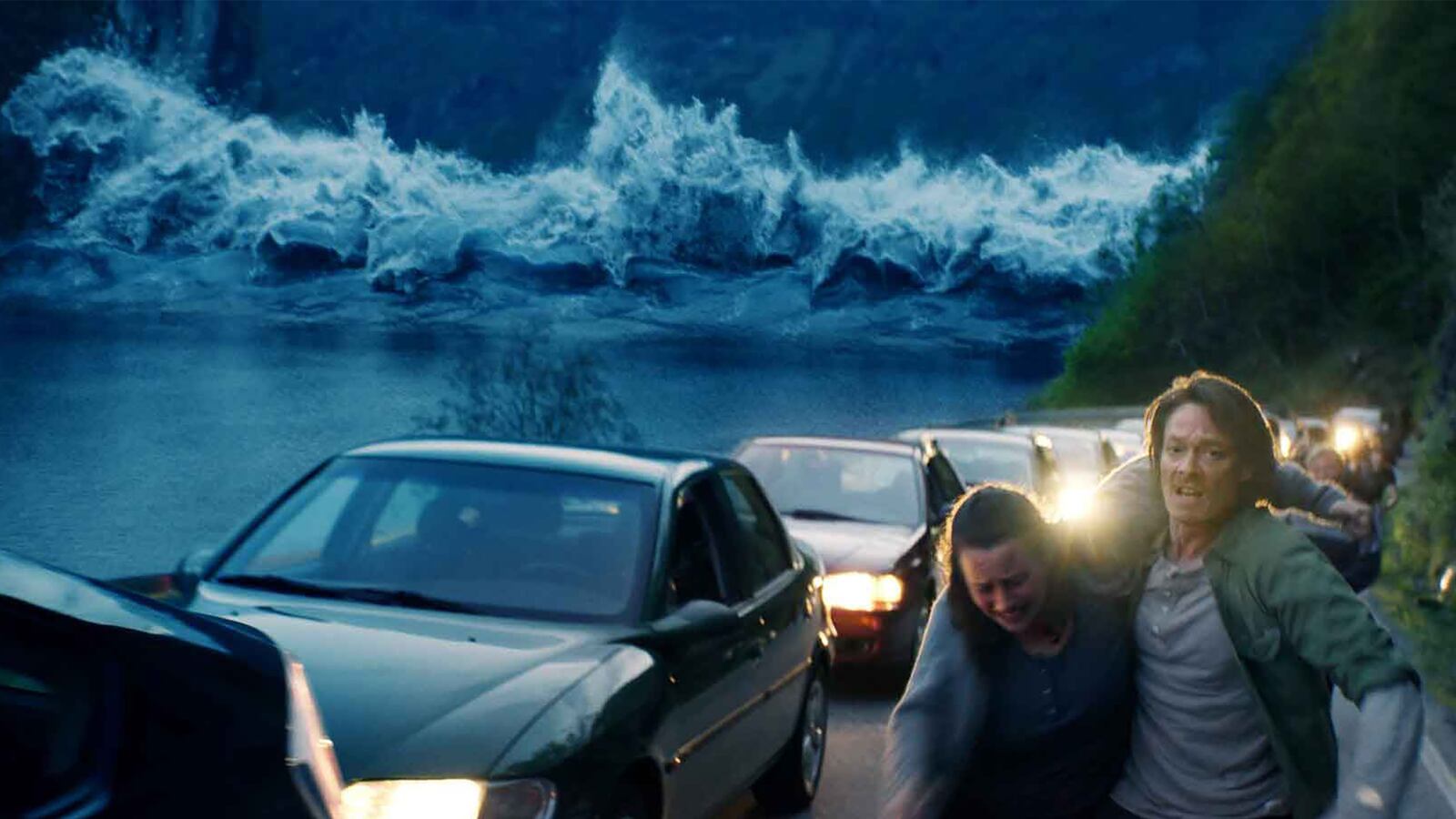The film the Norwegian tourism board can’t possibly want anyone to see, The Wave delivers the sort of expert disaster thrills that are sure to dissuade many from ever wanting to visit the picturesque county—or, at least, any of its small hamlets nestled between its imposing mountain ranges. A hit at last year’s Fantastic Fest and Toronto International Film Festival, as well as Norway’s submission for this year’s Academy Awards, Roar Uthaug’s intense import is a wholly fictional affair, albeit one couched in the authentic reality that his nation’s 300-odd mountains are slowly but surely contracting. And as a result, at some point there’s bound to be an avalanche that, when the rock slide hits the watery fjord below, creates a tidal wave of historically destructive proportions. As the film’s closing text makes clear, the question isn’t if this will happen—it’s when.
By rooting the proceedings in a believable real-world context, Uthaug does much to amplify the what-if horror of The Wave, which spends its first thirty minutes establishing both its setting and its scientific circumstances.
In the town of Geiranger, which sits at the base of Akerneset mountain, geologist Kristian (Kristoffer Joner) is preparing to relocate his family—wife Idun (Ane Dahl Torp), son Sondre (Jonas Hoff Oftebro), and daughter Julia (Edith Haagenrud-Sande)—to the big city, where a new job with an oil company awaits. That move means not only packing up their house and dealing with Sondre’s disappointment at having to depart this tranquil, gorgeous area, but also saying goodbye to his coworkers at the local station that monitors rockslides where, he discovers, strange readings seem to indicate that something’s happened to the cables used to detect changes in the mountains.
Uthaug’s characters are a rather formulaic bunch, but his cast personifies them with enough everyperson likability to make their impending nightmare tense, and the director does an assured job slowly building anticipation for his cataclysm. Unwilling to listen to his former boss and drop his suspicions that something is amiss, Kristian realizes—during an amusing epiphany sparked by his son’s Jenga-like smartphone game—that Akerneset’s cables must have been severed, thus causing him to irresponsibly abandon his kids in a car for hours while he descends into a mountain crevasse to confirm his fears. Alas, even the proof he finds isn’t enough to motivate his superiors to sound the regional alarm, meaning that he and Julia are soon spending one last night at their largely empty house, while Idun works a final shift at the local hotel and Sondre, preferring not to be around his neglectful dad, skateboards in the hotel basement with his headphones cranked to eleven—the better, for storytelling’s sake, to not hear the forthcoming warnings to evacuate.
The Wave’s breathtaking vistas of Akerneset’s peaks, often shrouded in misty clouds, lend the action a you-are-there visual splendor that contributes to its scenario’s plausibility—and, in the process, helps overshadow the fact that, at heart, Uthaug’s film is playing by a very familiar Hollywood blockbuster rulebook. With its protagonists’ splintered between separate locales, there’s double the madness when the mountain finally falls, begetting a gargantuan rush of water that rushes down the narrow inlet with rampaging speed and apocalyptic force. While working on a budget that clearly doesn’t afford the sort of AAA-grade CGI as your average big-studio work, The Wave does a serviceable job visualizing this natural monstrosity, climaxing with a shot of it barreling down on Kristian as he attempts to carry an injured woman past a row of log-jammed cars to a safe elevation, and of it charging into the hotel where Idun and Sondre have—out of sheer necessity—taken shelter in a basement room.
To say a lot of this has been done before would be true, but that rarely gets in the way of the film’s ability to manipulate one’s nerves. The Wave confirms that old tricks are still viable when perpetrated by skilled tricksters, and in fact, that what separates the good disaster films from the poor isn’t necessarily grand narrative ingenuity—in the end, all such genre efforts are required to pit largely helpless humans against Mother Nature’s callous wrath—but clever cinematic execution. Even when it has Kristian survive a jaw-dropping predicament, straining credulity in the process, Uthaug’s film manages to survive thanks to its director’s ability to modulate dramatic tone and rhythm just enough to sell the impossible as, if not wholly plausible, at least within the general realm of possibility.
Much of that is also due to a lead performance by Joner that never devolves into oversized superheroism. While there may be no more compelling global action star than Dwayne Johnson, his Rock-sized proportions and He-Man attitude were part of the reason last summer’s San Andreas was a flat disaster-show. When dialed to cartoonish levels, these films invariably come off as merely digital effects showcases divorced from any sense of real humanity—a problem that, consequently, renders the calamity itself emotionally uninvolving. Resembling a scruffier, longer-haired Nordic version of Norman Reedus (The Walking Dead), Joner roots his turn in unfussy agitated glances and harried reactions. He never makes Kristian seem destined for ultimate triumph, which is no small feat given that anyone acquainted with such big-screen endeavors knows that his protagonist’s fate isn’t apt to involve a watery grave.
This isn’t to claim that The Wave is a titanic departure from its domestic forefathers; on the contrary, part of what makes it so entertaining is that it clearly loves the conventions and clichés of the disaster film genre, duplicating them with both a fanboy’s glee and a shrewd storyteller’s belief in their enduring power to entertain. Refusing to temper (or apologize for) its enthusiasm for its material with wink-wink meta gestures, it merely delivers the destructive goods with irony-free craftsmanship. Its every slow zoom through a hallway and every close-up of a terrified countenance is designed only for ominous suspense and heart-racing terror—both of which it ably supplies, and in quantities all-too-rarely found these days in its Hollywood counterparts.





